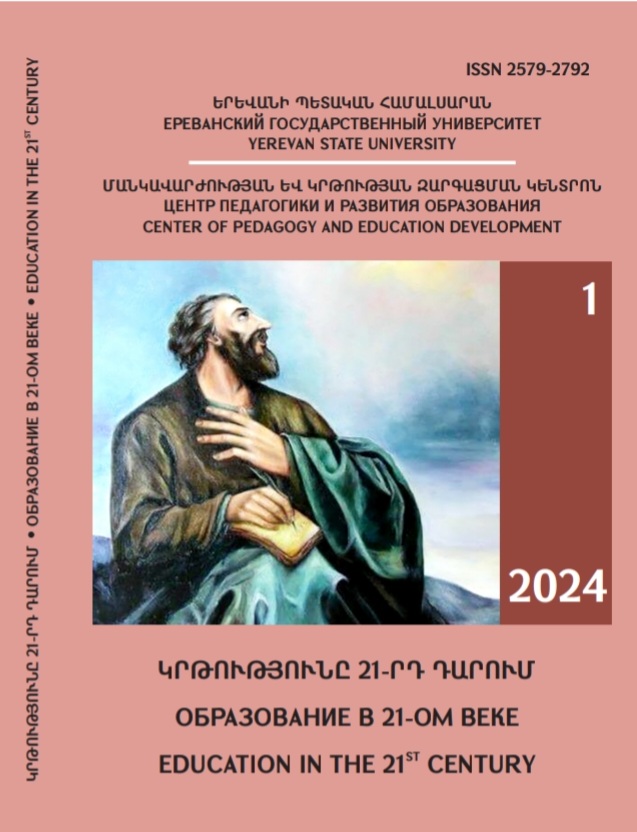THE ISSUE OF UNIFIED RELIGION TEXTBOOKS DURING THE ERA OF CATHOLICOS OF ALL ARMENIANS GEVORG IV
DOI:
https://doi.org/10.46991/ai.2024.1.170Keywords:
education policy, Christian textbook tradition, Catholicos of All Armenians, Gevork IV, catechetical, brief textsAbstract
Over time, textbook standards have changed. If in the early period of creating a textbook, the authors had limitations due to printing problems, today the creators of textbooks have wide opportunities. Periodically, new concepts were introduced into the textbooks, the format of tasks checking the understanding of the text was changed, the pictures accompanying the texts were added or reduced, the language, terminology, methodology, visual approaches of the textbooks were updated.
Nowadays, before a textbook reaches its recipient, its "hygiene" is assessed. The latter is determined by mathematical formulas: to what extent textbook texts are scientific, educational, appropriate for the age of the addressee, in accordance with a number of color and didactic requirements [12, 150].
Educational manuals with religious content are of great interest in the history of Armenian textbooks. The texts summarized in them, the methodology, the structure, a number of didactic solutions testify to the fact that we have a tradition of textbooks that are an integral part of Christian literature. Such undertakings have come a long way in the Armenian environment. During the period under review, there were a number of problems in the Eastern Armenian educational system: the schools did not have common charters, curricula, the issue of the types of schools was unclear. One of the key issues of education was having common textbooks in schools.
In the second half of the 19th century, the educational policy of Catholicos of All Armenians Gevorg IV was aimed at solving the above-mentioned problems. Under the guidance of the Catholicos, the process of creating unified Christian textbooks begins.
Here, we have presented the educational policy of Catholicos of All Armenians Gevorg IV, the steps he took in the direction of creating religious textbooks. For the first time, reference is made to the tradition of religious textbooks, which are part of the rich Christian literature in the Armenian educational environment, and the methodological features of the texts presented in them.
Currently, the study of such manuals creates an opportunity to communicate the tradition of Christian textbooks created in the Armenian educational environment, to analyze the methodological features of educational manuals, to use them as a guide for creating such textbooks in the present day.
The analysis of educational manuals proves that under the leadership of the Catholicos of All Armenians, a process of coordinating religion textbooks was created. Various authors have undertaken to create Christian manuals for schools. Textbooks are divided into two groups: a. manuals teaching the principles of the Christian religion, published under the title "Christian Doctrine", b. Textbooks presenting the moral stories of the Old and New Testaments, as well as the history of other religions. The authors of the manual were guided by two principles of the essay: catechetical (question and answer) and brief texts. Textbooks of Christian doctrine were written using the catechetical methodology, and other manuals were written using the methodology of brief texts.
References
Աբեղյան Մ., Գևորգ Դ Մեծագործ Կաթողիկոս Ամենայն Հայոց, Վաղարշապատ, Գ հրատարակություն, Վաղարշապատ, 2014:
Այվազեան Գաբրիել, Դասագիրք Քրիստոնեական վարդապետութեան ըստ ուղղափառ հաւատոյ Հայաստանեայց Ս. Եկեղեցւոյ, Վաղարշապատ, 1875թ:
Գ. Երզնկեանց, Դասավանդման խորհուրդներ, «Արարատ» Էջմիածին, 1892, N Է:
Երկանյան Վ., Պայքար հայկական նոր դպրոցի համար Անդրկովկասում, Երևան, 1970, էջ 16:
Խորեն Ստեփանե, Կրոնի դասատուութեան առաջընթաց եւ համանուագ եղանակներ, «Մանկավարժանոց», Թիֆլիս, 1889, N 3:
Խորեն Ստեփանե, Կրոնի դասատվության համակենտրոնական սիստեմ, Մանկավարժանոց, 1884, N 7-8
Կանոն յաղագս ծխական հոգևոր դպրոցացն Հայոց ի Ռուսաստան, «Արարատ», 1868, N Զ:
Կանոնադրութիւնք յաղագս թեմական դպրոցաց Հայոց որ ի Ռուսաստան, «Արարատ», 1869, N Ժ:
Կանոնադրութիւն Վանական դպրոցաց, «Արարատ», 1869, N Ա:
Կանոնք Ծխական Դպրոցաց, Վաղարշապատ, 1876:
Մանդինյան Ստ., Սրբազան պատմութիւն Հին և Նոր Ուխտի, Վաղարշապատ, 1872թ:
Մանդինյան Ստ., Համառոտ պատմութիւն Նոր Ուխտի, Վաղարշապատ, 1870թ:
Մխիթար Սեբաստացի, Քրիստոնէական վարդապետութիւն, 1727:
Մխիթարեան Աբել, Դասագիրք Քրիստոնեական հաւատոյ, Վաղարշապատ, 1874թ:
Շիրինյան Մ. Է., Քրիստոնեական վարդապետության անտիկ եւ հելլենիստական տարրերը, Երևան, 2005:
Սարգիս Գնունի, Քրիստոնեական վարդապետութիւնն ըստ ուղղափառ դավանության Հայ Առաքելական Սուրբ Եկեղեցվոյ, Վաղարշապատ, 1879թ:
Փափազեան Մ., Մանկավարժ վերծանութեան, Վաղարշապատ, 1872թ:
С. А. Михеева, Система формализованных критериев оценки школьного учебника, «Вопросы образования», 2015, N 4:
Downloads
Published
How to Cite
Issue
Section
License
Copyright (c) 2024 Mane Ghevondyan

This work is licensed under a Creative Commons Attribution-NonCommercial 4.0 International License.

